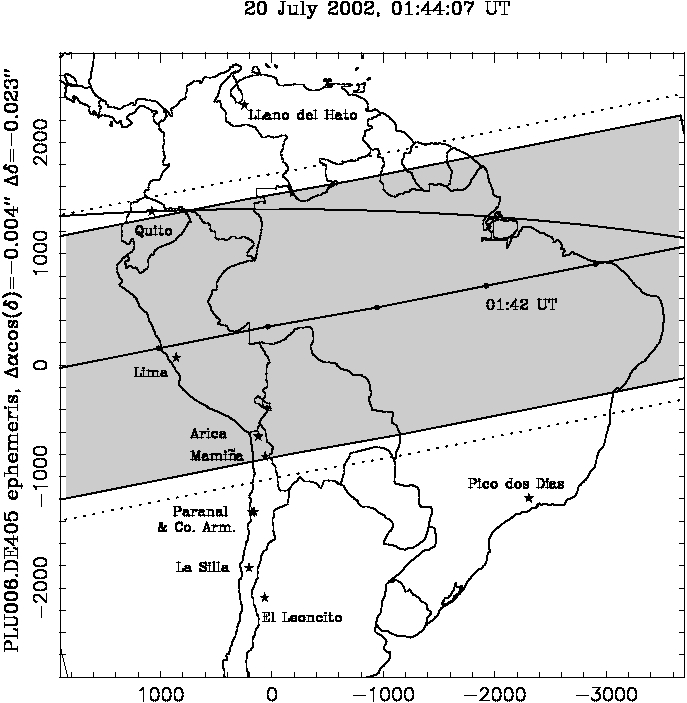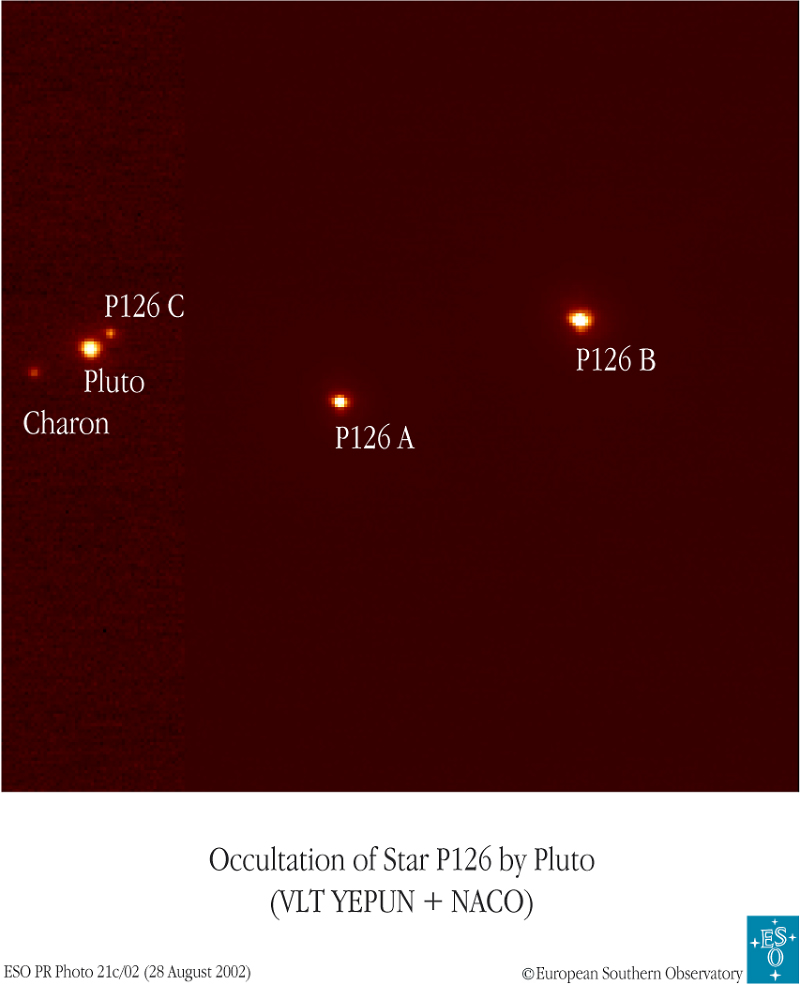

Two very rare phenomena involving the planet Pluto were recently observed within one month. On July 20 and again on August 21, 2002 (UT), Pluto actually passed in front of two different stars of Ophiuchus constellation, letting us peering for a few minutes through the planet tenuous atmosphere.
Due to the very small angular diameter of Pluto on the sky (0.1 arcsec or so), these exceptional phenomena, called occultations, are very scarce and difficult to predict well in advance.
One such event was observed in 1988, while those two new occultations were expected to occur in 2002, according to predictions published in 2000 by Steve W. McDonald and James L. Elliot from the Massachussetts Institute of Technology (MIT). (The stars have magnitudes V= 12.5 and V= 15.5, respectively, while pluto has about V= 13.9).
Further refinements provided by various observers, in particular Ronald C. Stone and colleagues at the U.S. Naval Observatory in Flagstaff, showed that the first event would be visible on July 20, 2002 from South America, while the second one on August 21 was expected to be observable in the Pacific basin, from the western coast of North America down to Hawaii and New Zealand.
A large campaign involving more than twenty scientists from Paris Observatory and associated institutions was organized to observe the July 20, 2002 occultation of the star referred to as "P126" in McDonald and Elliot's catalog.
Fixed telescopes in Brazil (LNA/Picos dos Dias), Argentina (CASLEO/El Leoncito), Chile (ESO/La Silla, ESO/Paranal, U. Católica del Norte/Cerro Armazones) and Venezuela (ULA/Llano del Hato) were involved in the campaign to follow this event. The refractors at these sites have diameters ranging from a fraction of a meter for the smallest instrument up to 8.2 meters for the ESO Very Large Telescope (VLT) at Paranal. The conditions of observations were ideal in South America, as the star with V = 12.5 was culminating near zenith at the moment of the occultation.
The object P126 eventually turned out to be a double star in May 2002, with the component "P126 A" of the system being likely to be occulted by Pluto as observed somewhere in South America. However, because of this duplicity, the predictions of where the shadow of Pluto would sweep the ground suffered a "large" uncertainty of 0.1 arcsec or more, corresponding to more that 2000 km on the ground. As Adaptive Optics of the image wre taken, a third companion, P126 C, also appeared, see Fig. 4.
As a consequence, small portable stations were also deployed in the last few days in Chile (near Arica), Peru (near Lima) and Ecuador (near Quito). Although small (with diameters between 20 and 35-cm) these telescopes were fit to get useful data, thus maximizing our chances to observe the event. In these occasions, the help of local amateur astronomers is priceless, as they can provide logistical help, and in several instances, telescopes.
Otherwise, click here for downloading a higher quality zipped postscript (*.ps.gz) version of the jpg image displayed below. 
Figure 1: path of Pluto's shadow on the Earth for the July 20 event. |
As it turned out, the occultation shadow went over Northern Chile, Peru and Ecuador, so that our group could eventually only get portable stations inside the band of Pluto's shadow.
Nevertheless, the "Yepun" VTL telescope at Paranal could acquire many high quality infrared images of the appulse of Pluto and P126 with the NACO Adaptive Optics camera. These images show that the Paranal site missed the upper layers of Pluto's atmosphere by a mere 200-km distance or so, equivalent to one hundredth of an arcsec projected on the sky!
Otherwise, click here for downloading a higher quality zipped postscript (*.ps.gz) version of the jpg image displayed below. 
Figure 2: chords across Pluto's atmosphere. |
Francois Colas and colleagues, in the meantime, were able to record the event from Northern Chile, near Arica, using a 30-cm diameter telescope and a fast CCD camera with no filter. All the other stations we had, fixed or not, were either outside the shadow, or under clouds, or with technical problems (or with all three at the same time).

Figure 3: path of Pluto's shadow on the Earth for the August 21 event. |
Stellar occultations are presently the only way to probe Pluto's tenuous atmosphere. The small stellar ray deviations due to refraction by the planet atmospheric layers, added to the huge distance to the observer (almost 4.5 billion km in the case of Pluto), causes a gradual decline of the stellar flux during the occultation, instead of the abrupt drop expected if the body were airless.
Pluto's atmosphere was first detected on August 19, 1985, during a stellar occultation observed from Israel by Noah Brosch. A much better signal to noise ratio data set was then obtained on July 9, 1988 from Australia by various ground-based observers, and from the Kuiper Airborne Observatory (KAO) by J.L. Elliot and colleagues.
However, after the 1988 event, Pluto's atmosphere was still uncompletely understood. The atmosphere appeared to be composed of a dominant gas of molar mass 28 g, probably nitrogen (as preferred over carbon monoxyde). Near-IR solar reflection spectra obtained by Leslie A. Young and her colleagues showed furthermore the presence of methane, which could have an abundance of up to 1% relative to nitrogen.
The KAO occultation light curve obtained in 1988 clearly revealed a duality of
regimes in Pluto' atmosphere, with a smooth isothermal profile in the outer
part, and a more abrupt drop of signal near the planet surface. This could be
interpreted as due to either
(1) a purely refractive transparent atmosphere with a sudden inversion layer
(increase of temperature with increasing altitude) near the planet cold
surface or
(2) haze layers with photochemical origin, which would obscure the stellar flux
by mere absorption as the occultation proceeded.
In order to discriminate between the various theoretical models of Pluto's atmosphere, simultaneous observations in the visible and in the infrared were planned by our group. While a purely refractive atmosphere would yield essentially the same light curves at all wavelengths, haze layers are expected to have a strong color dependence (opaque in the blue, more transparent in the IR), an effect which can be revealed by multi-wavelength experiments.
Another interesting issue which impulsed the 2002 occultation campaign was the possibility that Pluto's atmosphere changed since 1988. In the 14 year period elapsed since the last Pluto observed occultation, the planet has receded away from the Sun by 3%, due to its orbital eccentricity. This results in a change or 6% or so in the solar energy input at Pluto, a possible cause for driving changes in the surface temperature and in the atmospheric overall structure of Pluto.
As Pluto's shadow went north of the larger telescopes in Chile, Argentina and Brazil on July 20, we did not obtain IR data on that date. However, the broad band observations made with the portable station at Arica clearly detect the upper layers of the planet atmosphere for a little bit more than two minutes.
To within the uncertainty on the various parameters presently available (in particular the distance of the station to the center of the shadow, and the "polluting" contribution of the stellar companion P126 B to the total stellar flux), no major changes in Pluto's upper atmospheric structure since 1988 can be claimed from the Arica data.
The high resolution Adaptive Optics images obtained with the NACO camera just prior to the event at Paranal will be of great help for telling us where Pluto's shadow went over the Earth (the present accuracy is not much better than 300 km or so), and will thus tell us which altitudes of Pluto's atmosphere were probed.

Figure 4: Pluto and P126 A observed with NACO. |
Also, the comparison of this occultation chord timing with the timing of a an even more grazing occultation chord observed by Marc Buie (Lowell Observatory, Flagstaff) and Oscar Saa (Cerro Tololo Inter-American Observatory) at Mamiña, Chile, 200 km south of Arica, will substantially help pinning down the astrometry of the July 20 event.
Only with those future improvements can we proceed forward, and discuss the variation (or non-variation) of Pluto's upper atmosphere during the last 14 years.
In the meantime, the slower, better signal-to-noise ratio and more central occultation observed for almost seven minutes on August 21 at Mauna Kea with the CFHT already provides some clues to these issues, although the interpretation of the data is still provisional and will need further processing.
First, there is no clear indication at present that the upper, isothermal Pluto's atmospheric layers suffered drastic changes since 1988.
Second, an inversion (colder) layer, or an absorbing haze layer, or both, near Pluto's surface are clearly necessary to account for the CFHT light curve shape. Interestingly enough, the discontinuity in the slope of the light curve caused by this inversion (or haze) layer is less pronounced in the 2002 CFHT data than in the 1988 KAO data.
This could indicate that the atmosphere near Pluto's surface did suffer changes since 1988, with a shallower temperature gradient now than in 1988.
Another interpretation of the not so abrupt slope discontinuity in the August 21 CFHT light curve is that the putative haze layer in Pluto's lower atmosphere is more transparent in the near-IR domain (0.89 microns), where the CFHT data were obtained, than in the shorter wavelengths used for the 1988 KAO observations.
This raises the interesting possibility that the haze layer could eventually be confirmed when comparing the August 21 data obtained at different wavelengths from other telescopes.
Finally, the August 21 CFHT light curve definitively exhibits "spikes", i.e. sudden and short increases of signals over a few seconds. This indicates the presence of localized and abrupt variations of temperature with altitude, in an otherwise rather smooth temperature profile. This puzzling result could reveal a dynamical activity (waves) and/or the presence of localized haze layers in the atmosphere.
Bruno Sicardy
Observatoire de Paris
LESIA - 92195 Meudon Cedex Principal
with François Colas, Thomas Widemann , Françoise Roques, Christian Veillet, Jean-Charles Cuillandre, Nancy Ageorges, Wolfgang Beisker, Cyril Birnbaum, Kate Brooks, Audrey Delsanti, Pierre Drossart, Agnès Fienga, Eric Gendron, Olivier Hainaut, Mike Kretlow , François Lacombe, Anne-Marie Lagrange, Jean Lecacheux, Emmanuel Lellouch, Cédric Leyrat, Chris Lidman, Alain Maury, Elisabeth Raynaud, Michel Rapaport, Stefan Renner , Mathias Schultheis and Jason Spyromilio.
Most of the support for these observations was provided by the Conseil Scientifique of Paris Observatory, Paris University, the Programme National de Planetologie, the European Southern Observatory and the CNRS/Institut National des Sciences de l'Univers et de l'Environnement.
Last but not least, many thanks to C. Angeli, C. Ascueta, L. Barrera, D. Barria, A. Bruch, H. Calderon, R. Campos, S. Carrillo, A. Carvajal, L. Gaviria Cavero, D. Lazzaro, H. Levato, R. Machado, C. Montalve, O. Naranjo, L. Porras, E. Recalde, P. Rosenzweig, G. Rojas and U. Sanchez, who made the necessary and most welcome local arrangements in Argentina, Brazil, Chile, Ecuador, Peru and Venezuela.
